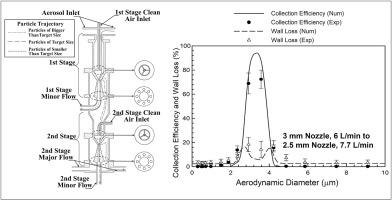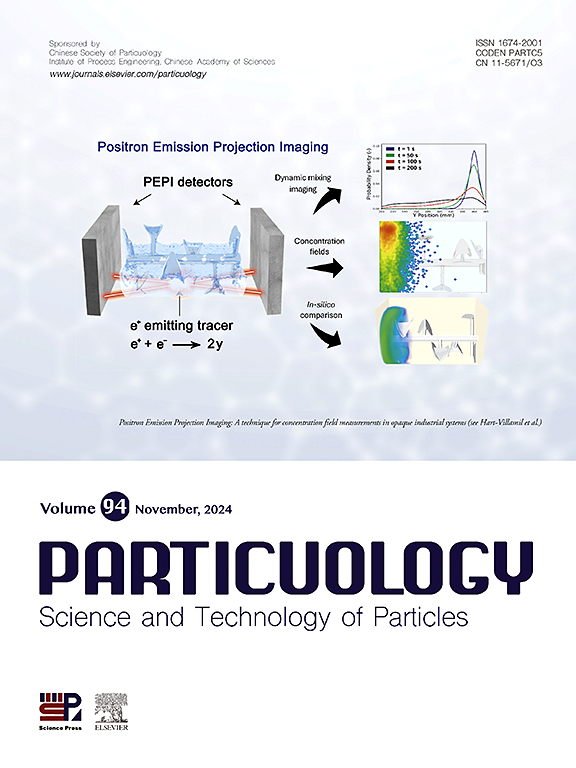开发用于生成微米级单分散气溶胶的两级虚拟撞击器
IF 4.1
2区 材料科学
Q2 ENGINEERING, CHEMICAL
引用次数: 0
摘要
单分散微粒因其均匀一致的小尺寸,在液晶显示器、太阳能电池和充电电池等广泛的工业应用中非常有用。然而,生成大量的单分散颗粒仍然具有挑战性。在本研究中,我们的目标是通过在狭窄的粒度范围内对微米级固体气溶胶颗粒进行分类来生成单分散气溶胶。因此,开发了一种新型粒度分级装置,该装置由两个串联的虚拟撞击器和洁净空气芯组成。第一级虚拟撞击器的截断尺寸略大于第二级,从第一级排出的主要气流被导向第二级。通过改变第一级和第二级的喷嘴尺寸或调整流速,可以改变目标粒度范围。随后,通过使用亚利桑那州测试粉尘进行实验,模拟并验证了两级虚拟冲击器的分级性能。第一级和第二级的截流尺寸组合分别为 3.0 和 2.0 μm、3.9 和 2.7 μm 或 6.7 和 4.8 μm。因此,单分散气溶胶粒子的几何标准偏差为 1.04-1.14,粒度范围为 2-6.7 μm。此处开发的两级虚拟撞击器可用于各种研究和性能评估,因为它可以对表现出高单分散性的微米级固体颗粒气溶胶进行分类。本文章由计算机程序翻译,如有差异,请以英文原文为准。

Development of a two-stage virtual impactor for the generation of micrometer-scale monodisperse aerosols
Monodisperse particles are useful across a wide range of industrial applications, such as LCD displays, solar cells and rechargeable batteries, due to their uniformly small sizes. However, generating high volumes of monodisperse particles remains challenging. In this study, it was aimed to generate monodisperse aerosols by classifying micrometer-scale solid aerosol particles within a narrow size range. Accordingly, a new particle-size classification device with two virtual impactors connected in series and clean air cores was developed. The first-stage virtual impactor had a slightly larger cutoff size than the second-stage, and the major flow discharged from the first-stage was directed to the second-stage. The target particle size range was altered by changing the nozzle sizes in the first and second stages or by adjusting the flow rate. Subsequently, the classification performance of the two-stage virtual impactor was simulated and validated through an experiment using Arizona test dust. The implemented combinations of cutoff sizes for the first and second stages were 3.0 and 2.0 μm, 3.9 and 2.7 μm, or 6.7 and 4.8 μm. As a result, monodisperse aerosol particles were classified at a geometric standard deviation of 1.04–1.14 and a particle size range of 2–6.7 μm. The two-stage virtual impactor developed herein may be useful for various research and performance evaluations, as it can classify micrometer-scale solid particle aerosols that exhibit high monodispersity.
求助全文
通过发布文献求助,成功后即可免费获取论文全文。
去求助
来源期刊

Particuology
工程技术-材料科学:综合
CiteScore
6.70
自引率
2.90%
发文量
1730
审稿时长
32 days
期刊介绍:
The word ‘particuology’ was coined to parallel the discipline for the science and technology of particles.
Particuology is an interdisciplinary journal that publishes frontier research articles and critical reviews on the discovery, formulation and engineering of particulate materials, processes and systems. It especially welcomes contributions utilising advanced theoretical, modelling and measurement methods to enable the discovery and creation of new particulate materials, and the manufacturing of functional particulate-based products, such as sensors.
Papers are handled by Thematic Editors who oversee contributions from specific subject fields. These fields are classified into: Particle Synthesis and Modification; Particle Characterization and Measurement; Granular Systems and Bulk Solids Technology; Fluidization and Particle-Fluid Systems; Aerosols; and Applications of Particle Technology.
Key topics concerning the creation and processing of particulates include:
-Modelling and simulation of particle formation, collective behaviour of particles and systems for particle production over a broad spectrum of length scales
-Mining of experimental data for particle synthesis and surface properties to facilitate the creation of new materials and processes
-Particle design and preparation including controlled response and sensing functionalities in formation, delivery systems and biological systems, etc.
-Experimental and computational methods for visualization and analysis of particulate system.
These topics are broadly relevant to the production of materials, pharmaceuticals and food, and to the conversion of energy resources to fuels and protection of the environment.
 求助内容:
求助内容: 应助结果提醒方式:
应助结果提醒方式:


